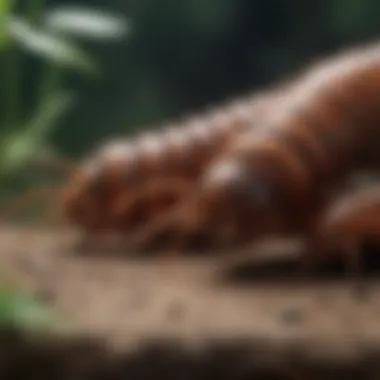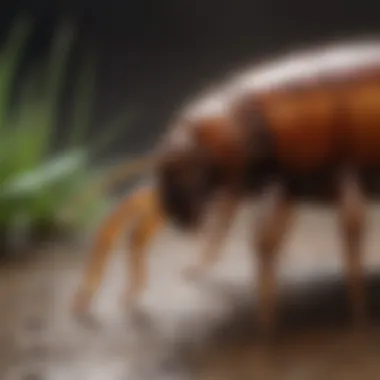Comprehensive Strategies to Effectively Eliminate House Centipedes


Animal Species Profile
Moving on to their behavior, house centipedes are solitary creatures that primarily hunt other pests like spiders and insects. Their natural habitat consists of spaces with high humidity levels, where they can maneuver swiftly to catch their prey. Understanding these characteristics is vital in developing effective strategies to eradicate them from our living spaces.
Unique Facts & Trivia
Exploring unique facts and trivia about house centipedes sheds light on their fascinating nature. One intriguing fact is that these arthropods possess specialized front legs that act as venomous fangs, incapacitating their prey effectively. Additionally, house centipedes exhibit remarkable regenerative abilities, being able to regrow lost limbs. This resilience contributes to their survival in various environments, making them intriguing subjects for study.
Moreover, house centipedes engage in a curious behavior known as 'lassoing,' where they ensnare their prey by swiftly coiling around them. This hunting technique showcases the agility and resourcefulness of these arthropods. Their propensity for hiding in crevices and under debris also makes them difficult to eliminate, as they are adept at evading detection.
Pet Care & Tips
While house centipedes may not be traditional pets, some individuals find themselves inadvertently sharing their living spaces with these creatures. To mitigate their presence, it is essential to eliminate attractive environments by reducing moisture and sealing entry points. Natural remedies like diatomaceous earth can be effective in deterring centipedes without posing risks to other pets or humans.
Furthermore, maintaining cleanliness and reducing clutter can discourage house centipedes from inhabiting a home. By understanding their behavior and preferences, homeowners can take proactive measures to prevent infestations. Implementing these pet care tips can create a less hospitable environment for house centipedes, ultimately leading to their eradication.
Understanding House Centipedes
House centipedes are captivating creatures with a unique anatomy and behavior that sets them apart from other pests. In this section, we delve into the significance of understanding these intriguing insects to effectively combat and prevent infestations. By exploring their physical characteristics, habitat, and behavior patterns, readers will gain valuable insights to tackle centipede issues. Understanding house centipedes forms the foundation for implementing successful elimination strategies.
Physical Characteristics of House Centipedes
Notable Features
Exploring the notable features of house centipedes unveils their exceptional traits that aid in survival and adaptation. Their long, slender bodies adorned with distinctive legs and antennae make them agile hunters in homes. Understanding these features is crucial for identification and differentiation from other household pests. Their rapid movements and ability to navigate challenging terrains make them formidable foes in infestation scenarios. Although intimidating to some, their beneficial role in controlling other pests cannot be overlooked.
Behavior Patterns
House centipedes exhibit fascinating behavior patterns that reflect their role in the ecosystem. Their nocturnal habits and preference for dark, damp areas enable them to thrive in hidden corners of homes. By understanding their behavior, homeowners can target areas where centipedes are likely to nest and breed. Their swift movements and predatory instincts make them efficient hunters, contributing to natural pest control. Despite their alarming appearance, house centipedes offer insights into insect behavior and ecosystem dynamics.
Habitat and Behavior
Preferred Environments
Exploring the preferred environments of house centipedes sheds light on their habitat requirements for survival. They favor moist areas such as bathrooms, basements, and crawl spaces, where they can find ample prey and shelter. Understanding these preferred environments helps homeowners in detecting and addressing centipede infestations effectively. By targeting their preferred habitats, individuals can disrupt centipede populations and prevent future outbreaks.
Typical Activities


House centipedes engage in a range of activities that showcase their adaptability and hunting prowess. From scavenging for food to mating rituals, their typical activities offer insights into their life cycle and behavior patterns. By observing these activities, individuals can identify centipede hotspots and implement targeted elimination strategies. Their ability to navigate diverse terrains and climates underscores their resilience as household pests. Understanding their typical activities is essential for devising comprehensive centipede control measures.
Identifying Infestation Signs
Identifying key signs of house centipede infestation is crucial in effectively managing and eradicating these pests. In this section, we delve into the specific elements, benefits, and considerations associated with Identifying Infestation Signs. By being able to recognize these signs early on, homeowners can take proactive measures to address the infestation promptly, preventing further spread.
Common Indicators of Centipede Presence
Visible Sightings
Visible sightings of house centipedes are a key indicator of their presence in a property. These sightings typically occur in areas with high moisture levels and abundant insect prey. The darting movement of house centipedes makes them distinguishable from other pests, such as spiders or ants. Despite their speed, these pests are often found in basements, bathrooms, and other damp areas, making visible sightings critical in detecting their infestation.
Trailing Marks
Trailing marks left by house centipedes are another telltale sign of their presence. These marks are often subtle and may go unnoticed by homeowners. However, they are typically found near baseboards, around pipes, or in cracks and crevices where centipedes hide. By paying attention to these marks, homeowners can track the movement patterns of centipedes and identify potential nesting areas.
Potential Nesting Areas
Dark and Damp Locations
House centipedes prefer dark and damp locations for nesting. Areas such as crawl spaces, utility rooms, and storage areas are ideal habitats for these pests. The combination of darkness and moisture provides centipedes with the necessary conditions to thrive. Identifying and addressing these areas is essential in reducing the centipede population within a property.
Typical Entry Points
Centipedes often gain entry into homes through typical entry points such as cracks in the foundation, gaps around doors and windows, and utility penetrations. These entry points serve as gateways for centipedes to access the interior of a property. By sealing these entry points and implementing preventative measures, homeowners can minimize the likelihood of centipede infestation.
Preventive Measures Against House Centipedes
Preventive measures against house centipedes are crucial in maintaining a pest-free environment. By focusing on specific elements like sealing cracks and crevices and managing moisture levels, homeowners can significantly reduce the risk of infestation. These measures play a vital role in preventing the entry and survival of house centipedes within living spaces. Not only do these strategies address current infestations, but they also serve as a proactive approach to deter future occurrences. Implementing preventive measures is key to fostering a healthy and comfortable living environment.
Effective Prevention Techniques
Sealing Cracks and Crevices
Sealing cracks and crevices is a fundamental aspect of controlling house centipedes. This technique involves identifying and sealing off any potential entry points where centipedes could infiltrate the residence. The primary characteristic of sealing cracks and crevices lies in its ability to create a physical barrier that restricts the movement of pests. By effectively sealing these openings, homeowners can limit the centipedes' access to indoor spaces, thereby reducing the likelihood of infestation recurrence. Despite its effectiveness, the process of sealing cracks and crevices requires meticulous attention to detail to ensure comprehensive coverage.
Managing Moisture Levels


Managing moisture levels is another essential component of preventing house centipede infestations. Centipedes thrive in moist environments, making it crucial to maintain low humidity levels within the home. The key advantage of managing moisture is that it creates an unsuitable habitat for centipedes, deterring their presence. While this approach is highly effective in combating centipedes, homeowners must strike a balance to prevent excessive drying of indoor spaces. Proper moisture management involves regular inspections and adjustments to ensure optimal humidity levels for human comfort while discouraging pest activity.
Minimizing Food Sources
Minimizing food sources is a proactive strategy to limit the attraction of house centipedes to residential areas. By focusing on removing insects and organizing clutter, homeowners can eliminate potential food supplies that sustain centipede populations.
Removing Insects
Removing insects serves as a primary method to reduce the food sources available to house centipedes. By effectively controlling insect populations in and around the home, homeowners can disrupt the centipedes' food chain, forcing them to seek sustenance elsewhere. The critical characteristic of this approach is its direct impact on centipede survival, leading to a decline in their presence over time. However, it is essential to implement safe and targeted insect removal techniques to avoid unintended harm to beneficial species and uphold ecological balance.
Organizing Clutter
Organizing clutter plays a significant role in minimizing potential hiding spots for house centipedes. Cluttered areas provide ideal harborage for centipedes, allowing them to establish nests and evade detection. By decluttering living spaces and storage areas, homeowners can limit the available hiding places, making it harder for centipedes to thrive. The unique feature of organizing clutter is its dual benefit of improving living conditions and reducing pest habitats simultaneously. Although clutter management requires ongoing commitment, the long-term advantages in pest prevention and overall home cleanliness make it a worthwhile endeavor.
Natural Remedies for House Centipedes
When tackling house centipede infestations, exploring natural remedies becomes a pivotal aspect. Not only do natural remedies offer an eco-friendly approach to pest control, but they also provide safer alternatives for households, particularly those with children and pets. In this context, the section on Natural Remedies for House Centipedes within this article stands out for its emphasis on fostering a harmonious coexistence between homeowners and the environment by prioritizing organic solutions.
Safe and Eco-Friendly Solutions
Essential Oils
Delving into the realm of safe and eco-friendly solutions, essential oils emerge as potent contenders against house centipedes. Their inherent properties, derived from plants and herbs, create powerful aromatic substances that repel these pests effectively. The key characteristic of essential oils lies in their natural origins, free from harsh chemicals commonly found in synthetic insecticides. This aspect not only appeals to environmentally conscious individuals but also ensures a reduced risk of toxic exposure within living spaces. Despite such benefits, essential oils do come with considerations such as varying efficacy levels depending on the oil type and application methods. Therefore, when implementing essential oils as a centipede deterrent, careful selection and proper usage are crucial for optimal outcomes.
Diatomaceous Earth
In the spectrum of eco-friendly solutions, diatomaceous earth stands as a stalwart defense against house centipedes. This powdery substance, composed of fossilized remains of diatoms, exerts its control by physically damaging the exoskeletons of these pests upon contact. The key characteristic of diatomaceous earth lies in its non-toxic nature, making it a favored choice for households aiming to minimize chemical exposure. Its unique feature, the abrasive properties that puncture the protective layer of centipedes, serves as a formidable barrier against infestations. However, despite its efficacy, diatomaceous earth may pose a challenge in damp environments due to reduced effectiveness when dampened.
Herbal Repellents
Lavender
As part of the herbal repellents arsenal, lavender emerges as a fragrant ally in the battle against house centipedes. Known for its calming scent and insect-repellent qualities, lavender offers a dual-purpose solution in creating a serene ambiance while deterring unwelcome pests. The key characteristic of lavender lies in its aroma, which not only adds a pleasant fragrance to living spaces but also serves as a natural centipede repellent. This distinctive feature makes lavender a popular choice for individuals seeking a holistic approach to pest management. However, considerations such as sensitivity to strong scents need to be acknowledged, especially for individuals with allergies or respiratory conditions.
Peppermint
In the realm of herbal repellents, peppermint asserts its position as a formidable centipede deterrent. The key characteristic of peppermint stems from its intense minty scent, which overwhelms the sensitive olfactory receptors of house centipedes, driving them away from treated areas. This aspect not only emphasizes peppermint's efficacy in pest control but also aligns with its reputation as a versatile herb with numerous household applications. While peppermint stands out for its natural potency against centipedes, it's essential to note that excessive application or concentration may lead to overpowering fragrances, necessitating moderation in usage for optimal results.


Chemical Control Options
Chemical control options play a crucial role in the battle against house centipedes. When natural remedies and preventive measures fall short, turning to chemical solutions becomes necessary to eliminate these resilient pests efficiently. By delving into the realm of chemical control, homeowners can address centipede infestations with precision and effectiveness.
Professional Pest Control Treatments
Professional pest control treatments constitute a vital aspect of combating house centipedes effectively. Among these treatments, insecticides stand out as a potent weapon in eradicating centipedes from homes. Insecticides are formulated to target and eliminate pests quickly, offering a rapid solution to infestations. While their immediate impact is beneficial, one must also consider potential drawbacks like chemical residues and environmental impact.
Insecticides
Insecticides are a cornerstone in the arsenal against house centipedes. These chemical formulations are designed to swiftly knock down centipede populations, providing homeowners with a potent means of control. The key characteristic of insecticides lies in their ability to target various life stages of centipedes, disrupting their reproductive cycle and population growth. Despite their efficacy, some insecticides may pose risks to children and pets, necessitating cautious application in homes.
Spray Treatments
Spray treatments offer a versatile approach to tackling house centipedes. The main advantage of spray treatments is their ability to cover a wide area, reaching crevices and hiding spots where centipedes dwell. While convenient and effective for immediate control, spray treatments may require repeated applications for long-term effectiveness. Moreover, improper use of sprays can lead to overexposure to chemicals and indoor air pollution, underscoring the importance of proper ventilation and application techniques.
Individual Application Methods
In addition to professional treatments, individual application methods empower homeowners to target centipedes directly. Dusts and baits serve as targeted solutions that address centipede infestations with a precise focus on areas of activity.
Dusts
Dusts play a critical role in the fight against centipedes by providing residual control in hard-to-reach areas. The key characteristic of dusts lies in their ability to adhere to surfaces and penetrate voids, reaching centipedes in their hiding spots. While effective, the main challenge with dusts is ensuring proper application to avoid accidental inhalation risks and contamination of living spaces.
Baits
Baits offer a strategic approach to luring and eliminating house centipedes. The key characteristic of baits is their attractive properties, drawing centipedes to consume the poison within. While effective in controlling centipede populations, baits must be used judiciously to prevent unintended exposure to non-target organisms and minimize environmental impacts.
Regular Maintenance Practices
House centipedes can be an unwelcome presence in any household, requiring diligent and regular maintenance practices to keep them at bay. This section delves into the critical role of regular maintenance in ensuring a centipede-free environment. By focusing on sustainable habits and consistent upkeep, individuals can effectively deter these creatures from taking residence within their homes. Emphasizing the importance of ongoing care and attention to detail, this guide sheds light on the key elements that contribute to a centipede-resistant home.
Sustainable Habits to Deter Centipedes
Cleaning Routines
A paramount aspect of regular maintenance practices is the implementation of thorough cleaning routines. These routines play a pivotal role in reducing attractants that might draw centipedes into living spaces. By eliminating food sources, hiding spots, and moisture buildup, cleaning routines disrupt the centipedes' ideal habitats and inhibit their proliferation. The consistency and precision of cleaning schedules are crucial in maintaining a centipede-unfriendly environment, making it an essential element of effective pest control strategies for homeowners.
Outdoor Maintenance
Outdoor maintenance encompasses a variety of activities aimed at fortifying the home against centipede infestations. From sealing entry points to eliminating potential shelters around the perimeter, outdoor maintenance serves as a primary line of defense against these agile pests. By minimizing vegetation near the house, keeping outdoor areas dry, and securing openings that might serve as centipede entry points, homeowners can significantly reduce the likelihood of infestations. The proactive nature of outdoor maintenance fosters a preventative approach to centipede control, offering long-term benefits in preserving a pest-free living environment.
Monitoring and Inspection
Significant for early intervention and containment of centipede populations, monitoring and inspection procedures are indispensable components of effective pest management. By employing early detection strategies, homeowners can identify centipede presence before infestations escalate, enabling targeted interventions to address the issue promptly. Regular routine checks further bolster the household's defense mechanisms by establishing a consistent monitoring framework to track centipede activity levels and assess the effectiveness of implemented control measures. The vigilance and thoroughness required in monitoring and inspection practices are key to maintaining a harmonious living space free from centipede intrusions.







